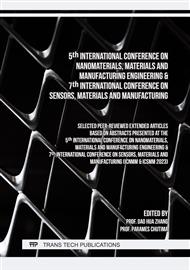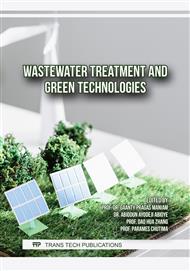[1]
Y.S. Wudil, U.F. Ahmad, M.A. Gondal, Mohammed A. Al-Osta, Abdullah Almohammedi, R.S. Sa'id, F. Hrahsheh, K. Haruna and M.J.S. Mohamed: Arab. J. Chem. Vol. 16(3) (2023), p.104542
DOI: 10.1016/j.arabjc.2023.104542
Google Scholar
[2]
Alaghmandfard, A. and Ghandi, K.: Nanomaterials Vol. 12 (2022), p.294
Google Scholar
[3]
Qian Wang, Yongfei Li, Fenglin Huang, Shaofu Song, Ganggang Ai, Xin Xin, Bin Zhao, Yajun Zheng and Zhiping Zhang: Molecules Vol. 28 (2023), p.432
Google Scholar
[4]
Alaghmandfard A and Ghandi K., A: Nanomaterials (Basel). Vol. 12(2) (2022), p.294
Google Scholar
[5]
S. Vinoth and A. Pandikumar: RES. Vol.173 (2021), p.507
Google Scholar
[6]
Maha Alhaddad, R.M. Navarro, M.A. Hussein and R.M. Mohamed: J. Mater. Res. Vol. 9(6) (2020), p.15335
Google Scholar
[7]
Xiuhua Wei, Xing Qiao, Jie Fan, Hui Dong, Yintang Zhang, Yanli Zhou and Maotian Xu: Arab. J. Chem. Vol. 15(10) (2022), p.104092
Google Scholar
[8]
Sultan Alhassan, Khulaif Alshammari, Majed Alshammari, Turki Alotaibi and Alhulw H. Alshammari: Results Phys. Vol. 48 (2023), p.106403
DOI: 10.1016/j.rinp.2023.106403
Google Scholar
[9]
Haoye Wang, Aijuan Xie, Shuji Li, Jiajun Wang, Kaixuan Chen, Zilong Su, Ningning Song and Shiping Luo: Anal. Chim. Acta. Vol. 1211 (2022), p.339907
Google Scholar
[10]
Forough Goudarzy, Javad Zolgharnein and Jahan B. Ghasemi: Inorg. Chem. Commun. Vol. 141 (2022), p.109512
Google Scholar
[11]
Muhammad Azam Qamar, Mohsin Javed, Sammia Shahid, Mohammad Shariq, Mohammed M. Fadhali, Syed Kashif Ali and Mohd. Shakir Khan: Heliyon. Vol. 9(1) (2023), p.12685
Google Scholar
[12]
Muhammad Zeeshan Asghar, Khadijah Mohammedsaleh Katubi, Mehboob Hassan, Z.A. Alrowaili, Muhammad Usama Arif, Memoona Qammar, M.S. Al-Buriahi, Muhammad Shahid Mahmood and Mirza Mahmood Baig: Diam Relat Mater. Vol. 135 (2023), p.109850
DOI: 10.1016/j.diamond.2023.109850
Google Scholar
[13]
Waqar A. Abdulnabi, Saad H. Ammar and Huda D. Abdul Kader: Inorg. Chem. Commun. Vol. 150 (2023), p.110533
Google Scholar
[14]
Gebreslassie G, Gebrezgiabher M, Lin B, Thomas M and Linert W.: Inorganics. Vol. 11(3) (2023), p.119
Google Scholar
[15]
Mehrnaz Babaei Shekardasht, Mohammad Hadi Givianrad, Parvin Gharbani, Zohreh Mirjafary and Ali Mehrizad: Diam Relat Mater. Vol. 109 (2020), p.108008
DOI: 10.1016/j.diamond.2020.108008
Google Scholar
[16]
Periyathambi Kalisamy, Md Shahadat Hossain, Romulo R. Macadangdang Jr., V. Madhubala, Baskaran Palanivel, Munusamy Venkatachalam, Ehab El Sayed Massoud and Gedi Sreedevi: Inorg. Chem. Commun. Vol.135 (2022), p.109102
DOI: 10.1016/j.inoche.2021.109102
Google Scholar
[17]
Heshan Liyanaarachchi, Charitha Thambiliyagodage, Chamika Liyanaarachchi and Upeka Samarakoon: Arab. J. Chem. Vol. 16(6) (2023), p.104749
DOI: 10.1016/j.arabjc.2023.104749
Google Scholar
[18]
Zhengqiaoruo Zhu, Nan Zhou, Yakun Li, Xiaoli Zhang and Linlin Zhang: Mater. Sci. Semicond. Vol. 160 (2023), p.107423
Google Scholar
[19]
VP Letswalo, LN Dlamini, SP Malinga: Environmental Advances. Vol. 10 (2022), p.100322
Google Scholar
[20]
Sourav Chakraborty and Yoel Sasson: Results Chem. Vol. 4 (2022), p.100410
Google Scholar
[21]
O. Aldaghri, A. Modwi, Hajo Idriss, M.K.M. Ali and K.H. Ibnaouf: Diam Relat Mater. Vol. 129 (2022), p.109315
Google Scholar
[22]
Timothy O. Ajiboyea, Opeyemi A. Oyewo, Youssef Ben Smida and Damian C. Onwudiwe: RINENG. Vol. 15 (2022), p.100540
Google Scholar
[23]
Zhengdong Xu, Jiahua Zhang, Junbo Zhong, Jiao Wu and Minjiao Li: Mater. Sci. Semicond. Vol. 161 (2023), p.107459
Google Scholar
[24]
Kamel Eid, Mostafa H. Sliem, Amal S. Eldesoky and Aboubakr M. Abdullah: Data in Brief. Vol. 27 (2019), p.104734
Google Scholar
[25]
Kamel Eid and Aboubakr M. Abdullah: Data in Brief. Vol. 26 (2019), p.104495
Google Scholar
[26]
Kamel Eid, Mostafa H. Sliem, Khouloud Jlassi, Amal S. Eldesoky, Ghada G. Abdo, Siham Y. Al-Qaradawi, Mohammed A. Sharaf, Aboubakr M. Abdullah and Ahmed A. Elzatahry: Inorg. Chem. Commun. Vol. 107 (2019), p.107460.
DOI: 10.1016/j.inoche.2019.107460
Google Scholar
[27]
Jianxin Li, Yuhua Wang, Yitong Wang, Yao Guo, Shiding Zhang, Haixiang Song, Xianchang Li, Qianqian Gao, Wanyu Shang, Shuaishuai Hu, Huibin Zheng and Xifei Li: NMS. Xxx (2023) ISSN 2589-9651
Google Scholar
[28]
Marwa A. Lafta and Saad H. Ammar: Mater. Sci. Semicond. Vol. 153 (2023), p.107131
Google Scholar
[29]
Sangjan S and Thongsamer W.: KEM. Vol. 858 (2020), p.109
Google Scholar
[30]
Pattanasiri B and Sangjan S.: KEM. Vol. 931 (2022), p.99
Google Scholar
[31]
Li, F. and Lin, M.: Int. J. Environ. Res. Public Health. Vol. 17 (2020), p. (2065)
Google Scholar
[32]
Hong Wang, Xianzhao Shao, Junhai Liu, Qiang Zhang, Xiaohui Ji and Guanghui Tian: Environ. Saf. Vol. 205 (2020), p.111147
Google Scholar
[33]
Chen, X., He, M. and He, G.: Appl Nanosci. Vol. 10 (2020), p.4465
Google Scholar
[34]
Imran Aslam, M. Hassan Farooq, Usman Ghani, M. Rizwan, Ghulam Nabi, Waseem Shahzad and Rajender Boddula: Mater. Sci. Energy Technol. Vol. 2(3) (2019), p.401
DOI: 10.1016/j.mset.2019.04.008
Google Scholar
[35]
Jing Feng, Mingming Gao, Zhiqiang Zhang, Mengzhen Gu, Jinxin Wang, Wenjing Zeng and Yueming Ren: Results Phys. Vol. 11 (2018), p.331
Google Scholar




